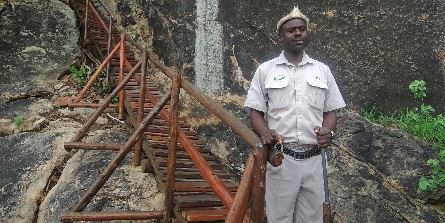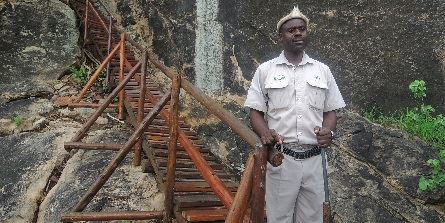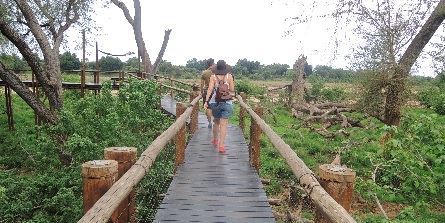Kim Emmanuel visited Mapungubwe National Park as a guest of Wilderness Safaris and the Department of Environmental Affairs: Boundless Southern Africa. She shares some of the unique experiences on offer.
Mapungubwe National Park, a transfrontier park, is on the borders of South Africa, Zimbabwe and Botswana. Apart from the safari experience, guests also have the opportunity to learn more about the history of the area and view some of the artefacts discovered there from about 1932. The artefacts date back to around AD1 200 and include glass beads and a golden rhino.
The transfrontier nature of the park allows guests to experience the wildlife offering of three different countries. The park is also an ideal destination for self-drivers. Temperatures are generally mild during South Africa’s winter and hot in summer.
How to get there
From Johannesburg, visitors can travel by road, taking the N1 North to Polokwane. In Polokwane CBD take R521 to Dendron, passing the town of Alldays, and travelling a further 23km to the Mapungubwe entrance and reception. The journey takes about six hours. The roads are generally in good condition, with potholes and wandering game only appearing closer to the park.
The closest airport is Polokwane International Airport, from where guests travel 215km along the R521 to the park entrance.
SANParks also lists a daily coach service on its website, from Gauteng to Musina. From Musina, guests will travel an hour to the park entrance.
Guests can also make use of Ashtons’ on-demand transfer services. The transfer from Johannesburg to Mapungubwe with Ashtons will take between five and six hours. Springbok Atlas also offers transfers to the park on a request basis.
Where to stay

Leokwe Camp in Mapungubwe National Park.
Mapungubwe National Park has a range of accommodation options.
Vhembe Wilderness Camp is a self-catering accommodation facility with four units, each able to accommodate two adults. Each unit has its own en-suite bathroom. Communal areas include a kitchen, dining and braai area.
Each unit also has a small deck area overlooking a valley often visited by wildlife, including elephants and a variety of buck. Additional facilities at the camp include a swimming pool.
Leokwe Camp is the main accommodation camp and comprises 17 cottages able to accommodate a maximum of two guests and two family cottages able to accommodate up to four guests each. Each unit has an open-plan kitchen, en-suite bathroom and braai (barbecue) facilities.
Guests can also easily enjoy the nearby treetop hide and the confluence view site and picnic area. Additional facilities include a swimming pool and sundeck, as well as a central braai area.
For the more adventurous traveller, Mazhou camping site caters for 10 caravans or tents. Each camping site is equipped with a power point.
What to do

Stairway leading to the top of Mapungubwe hill.
A guided tour up Mapungubwe Hill is a must-do activity for any traveller visiting the area. Guests meet their guide at the park’s reception area where they are taken by game vehicle to Mapungubwe Hill. Along the way, there are plenty of opportunities to catch sight of wildlife and the different species of flora. At the foot of the hill, guests walk to an excavation site, where the history of Mapungubwe is explained by the knowledgeable guide. The guide then escorts guests up the stairway leading to the top of the hill. Atop the hill is the graveyard where the royal family of the Mapungubwe Kingdom are buried, tools used by the ancestral Mapungubwe people, as well as a panoramic view of the natural amphitheatre, while a guide provides interesting and comprehensive explanations.
Mapungubwe National Park is home to various wildlife species including elephant, giraffe, rhino, different antelope species, and even lions. Guests visiting the park are very likely to come across wildlife, not only while driving through the park, but also just outside their rooms or cottages.

Treetop walk at Mapungubwe.
Apart from wildlife, the area also has some beautiful views that can be enjoyed from several locations. From the treetop hide and walkway guests can view animals along the Limpopo River, and are often joined by baboons scurrying along the walkway. The confluence viewing decks highlight the view of the Shashe and Limpopo rivers where the three countries, South Africa, Zimbabwe and Botswana meet. Visiting the confluence at sunset is an ideal end to the day. A picnic site near the viewing decks offers shaded picnic spots with tables and taps along with ablution facilities. Guests can also hire a skottel braai and get basic necessities at the tuckshop.
The Maloutswa bird hide is a short drive from Limpopo Forest Tented Camp and the Mazhou Camping Site. Bird enthusiasts and animal lovers will appreciate the location, from where they can view birds and mammals of all kinds visiting the river.
Mapungubwe Interpretive Centre houses a museum section that has many of the artefacts uncovered in the park on display. Information on the park's fascinating history and biology is also available at the Interpretive Centre with knowledgeable guides on hand to take visitors through the centre. A curio shop is near the centre.
























